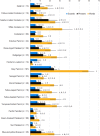A survey of vocal mimicry in companion parrots
- PMID: 36470907
- PMCID: PMC9722931
- DOI: 10.1038/s41598-022-24335-x
A survey of vocal mimicry in companion parrots
Abstract
Parrots are one of the rare animal taxa with life-long vocal learning. Parrot vocal repertoires are difficult to study in the wild, but companion parrots offer a valuable data source. We surveyed the public about mimicry repertoires in companion parrots to determine whether vocal learning varied by (1) species, (2) sex, (3) age, and (4) social interaction with other parrots. Species differed significantly in mimicry ability, with grey parrots (Psittacus erithacus) having the largest mimicry repertoires. Analyses of all birds (n = 877) found no overarching effects of sex, age, or parrot-parrot social interactions on mimicry repertoires. Follow up analyses (n = 671), however, revealed a human bias to assume that talking parrots are male, and indicated that five of the 19 best-sampled species exhibited sex differences. Age-specific analyses of grey parrots (n = 187) indicated that repertoire size did not increase during adulthood. Most parrots were capable of improvisation (e.g. rearranging words) and used mimicry in appropriate human contexts. Results indicate that parrot vocal production learning varies among and within species, suggesting that the mechanisms and functions of learning also vary. Our data provide a rich foundation for future comparative research on avian vocalizations, and broaden our understanding of the underpinnings of communicative behavior and learning across all animals.
© 2022. The Author(s).
Conflict of interest statement
The authors declare no competing interests.
Figures



References
MeSH terms
LinkOut - more resources
Full Text Sources

